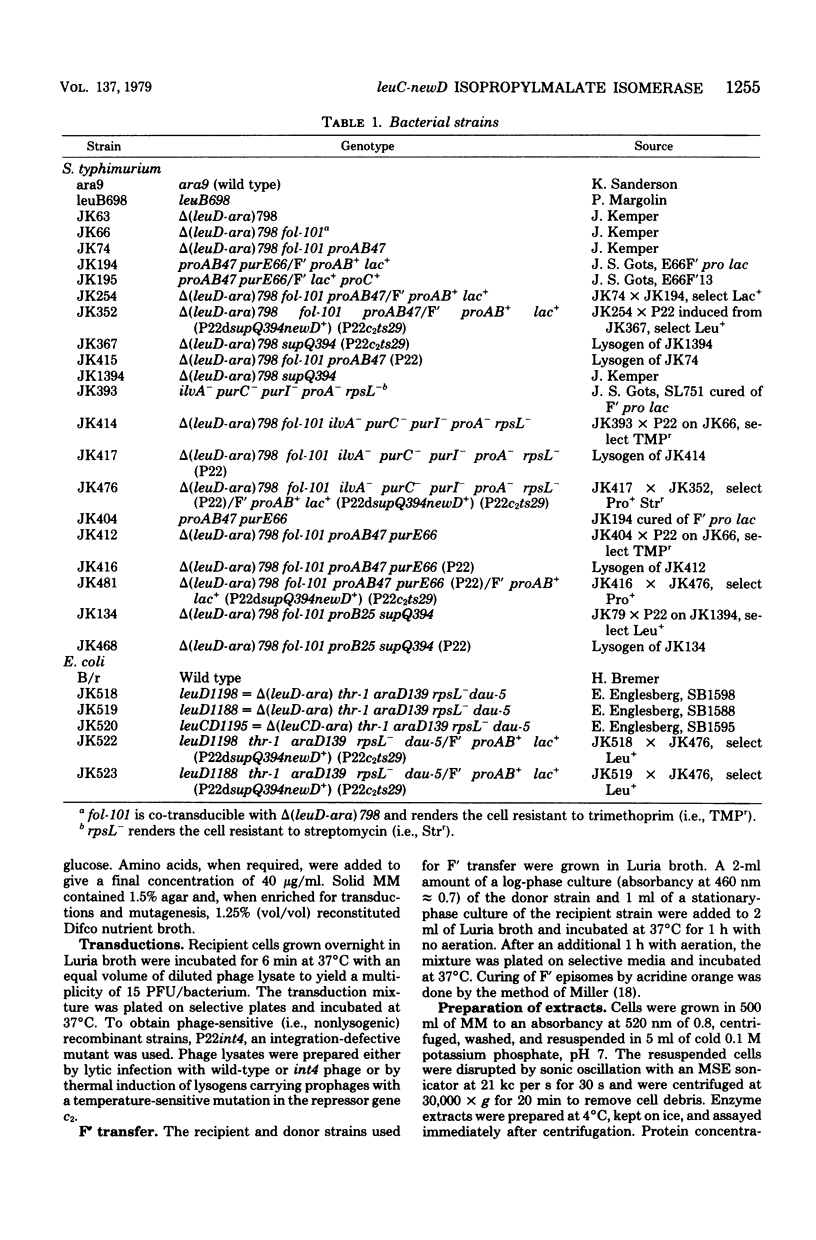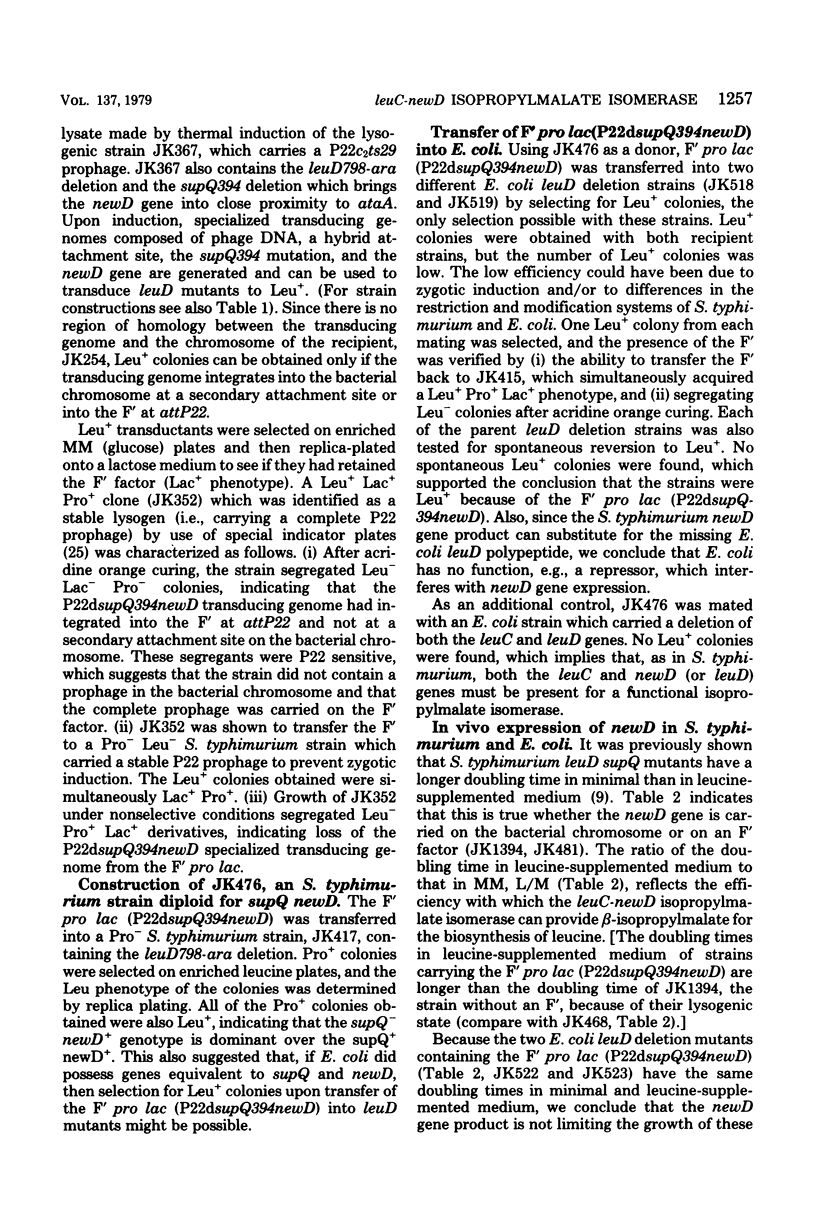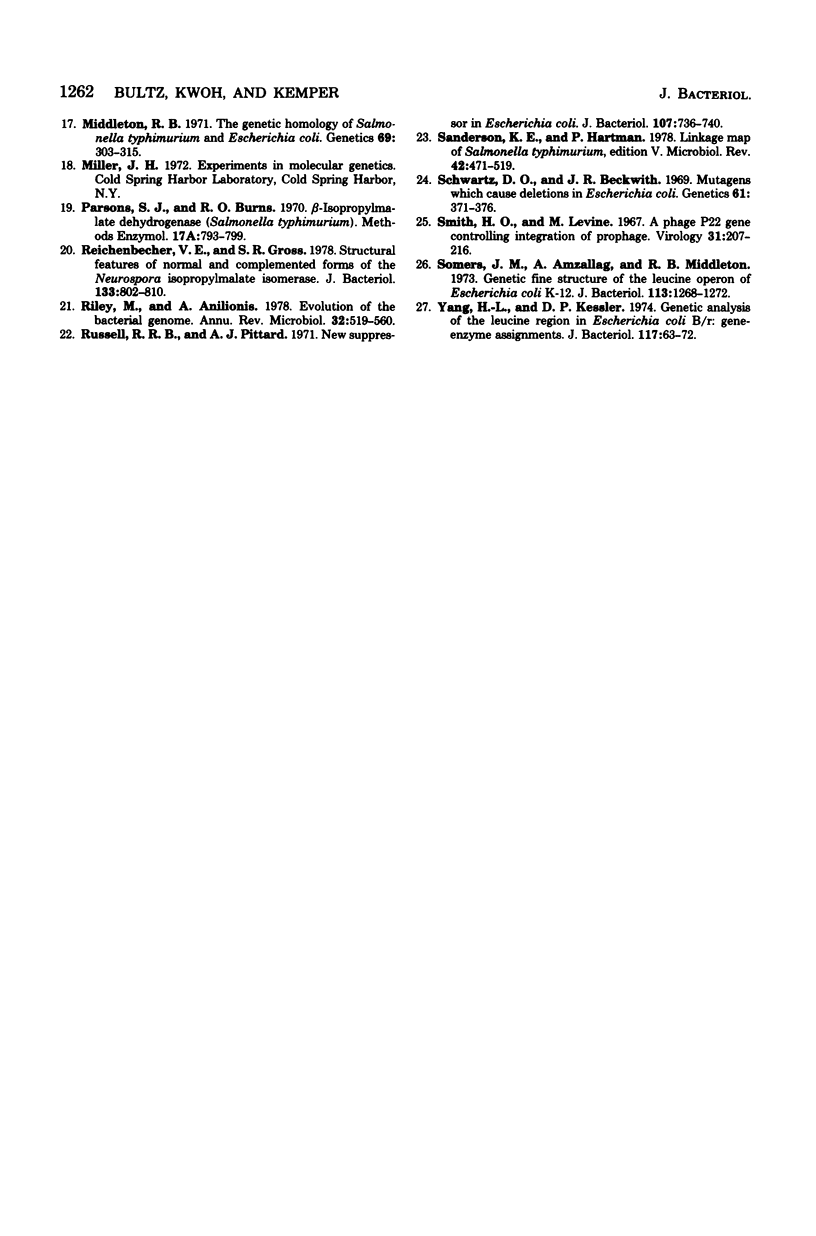Abstract
The supQ newD gene substitution system in Salmonella typhimurium restores leucine prototrophy to leuD mutants by providing the newD gene product which is capable of replacing the missing leuD polypeptide in the isopropylmalate isomerase, a complex of the leuC and leuD gene product. Mutations in the supQ gene are required to make the newD protein available. An Escherichia coli F' factor was constructed which carried supQ- newD+ from S. typhimurium on a P22-specialized transducing genome. This F' pro lac (P22dsupQ394newD) episome was transferred into S. typhimurium strains containing th leuD798-ara deletion; the resulting merodiploid strains had a Leu+ phenotype, indicating that supQ- newD+ is dominant over supQ+ newD+, and eliminating the possibility that the supQ gene codes for a repressor of the newD gene. Furthermore, transfer of the F' pro lac (P22dsupQ39newD) into E. coli leuD deletion strains restored leucine prototrophy, showing that the S. typhimurium newD gene can complment the E. coli leuC gene. Growth rates of the S. typhimurium-E coli hybrid strains indicated that the mutant isopropylmalate isomerase in these strains does not induce a leucine limitation, as it does in S. typhimurium leuD supQ mutants. In vitro activity of the mutant isopropylmalate isomerase was demonstrated; the Km values for alpha-isopropylmalate of both the S. typhimurium leuC-newD isomerase and the S. typhimurium-E. coli hybrid isomerase were as much as 100 times higher than the Km values for alpha-isopropylmalate of the wild-type enzyme, which was 3 x 10(-4) M. Mutagenesis of E. coli leuD deletion strains failed to restore leucine prototrophy, indicating that E. coli does not have genes analogous to the S. typhimurium supQ newD genes, of that, if present, activation of a newD is a rare event or is lethal to the cell.
Full text
PDF









Selected References
These references are in PubMed. This may not be the complete list of references from this article.
- Bachmann B. J., Low K. B., Taylor A. L. Recalibrated linkage map of Escherichia coli K-12. Bacteriol Rev. 1976 Mar;40(1):116–167. doi: 10.1128/br.40.1.116-167.1976. [DOI] [PMC free article] [PubMed] [Google Scholar]
- Bigelis R., Umbarger H. E. Purification of yeast alpha-isopropylmalate isomerase. High ionic strength hydrophobic chromatography. J Biol Chem. 1975 Jun 10;250(11):4315–4321. [PubMed] [Google Scholar]
- Bigelis R., Umbarger H. E. Yeast alpha-isopropylmalate isomerase. Factors affecting stability and enzyme activity. J Biol Chem. 1976 Jun 25;251(12):3545–3552. [PubMed] [Google Scholar]
- Crawford I. P. Gene rearrangements in the evolution of the tryptophan synthetic pathway. Bacteriol Rev. 1975 Jun;39(2):87–120. doi: 10.1128/br.39.2.87-120.1975. [DOI] [PMC free article] [PubMed] [Google Scholar]
- GROSS S. R., BURNS R. O., UMBARGER H. E. THE BIOSYNTHESIS OF LEUCINE. II. THE ENZYMIC ISOMERIZATION OF BETA-CARBOXY-BETA-HYDROXYISOCAPROATE AND ALPHA-HYDROXY-BETA-CARBOXYISOCAPROATE. Biochemistry. 1963 Sep-Oct;2:1046–1052. doi: 10.1021/bi00905a023. [DOI] [PubMed] [Google Scholar]
- Guerola N., Ingraham J. L., Cerdá-Olmedo E. Induction of closely linked multiple mutations by nitrosoguanidine. Nat New Biol. 1971 Mar 24;230(12):122–125. doi: 10.1038/newbio230122a0. [DOI] [PubMed] [Google Scholar]
- Hoppe I., Roth J. Specialized transducing phages derived from salmonella phage P22. Genetics. 1974 Apr;76(4):633–654. doi: 10.1093/genetics/76.4.633. [DOI] [PMC free article] [PubMed] [Google Scholar]
- Kemper J. Evolution of a new gene substituting for the leuD gene of Salmonella typhimurium: characterization of supQ mutations. J Bacteriol. 1974 Sep;119(3):937–951. doi: 10.1128/jb.119.3.937-951.1974. [DOI] [PMC free article] [PubMed] [Google Scholar]
- Kemper J. Evolution of a new gene substituting for the leuD gene of Salmonella typhimurium: origin and nature of supQ and newD mutations. J Bacteriol. 1974 Dec;120(3):1176–1185. doi: 10.1128/jb.120.3.1176-1185.1974. [DOI] [PMC free article] [PubMed] [Google Scholar]
- Kemper J., Margolin P. Suppression by gene substitution for the leuD gene of Salmonella typhimurium. Genetics. 1969 Oct;63(2):263–279. doi: 10.1093/genetics/63.2.263. [DOI] [PMC free article] [PubMed] [Google Scholar]
- Kwoh D. Y., Kemper J. Bacteriophage P22-mediated specialized transduction in Salmonella typhimurium: identification of different types of specialized transducing particles. J Virol. 1978 Sep;27(3):535–550. doi: 10.1128/jvi.27.3.535-550.1978. [DOI] [PMC free article] [PubMed] [Google Scholar]
- LEVINE M. Mutations in the temperate phage P22 and lysogeny in Salmonella. Virology. 1957 Feb;3(1):22–41. doi: 10.1016/0042-6822(57)90021-1. [DOI] [PubMed] [Google Scholar]
- LOWRY O. H., ROSEBROUGH N. J., FARR A. L., RANDALL R. J. Protein measurement with the Folin phenol reagent. J Biol Chem. 1951 Nov;193(1):265–275. [PubMed] [Google Scholar]
- Low K. B. Escherichia coli K-12 F-prime factors, old and new. Bacteriol Rev. 1972 Dec;36(4):587–607. doi: 10.1128/br.36.4.587-607.1972. [DOI] [PMC free article] [PubMed] [Google Scholar]
- MARGOLIN P. Genetic fine structure of the leucine operon in Salmonella. Genetics. 1963 Mar;48:441–457. doi: 10.1093/genetics/48.3.441. [DOI] [PMC free article] [PubMed] [Google Scholar]
- Middleton R. B. The genetic homology of Salmonella typhimurium and Escherichia coli. Genetics. 1971 Nov;69(3):303–315. doi: 10.1093/genetics/69.3.303. [DOI] [PMC free article] [PubMed] [Google Scholar]
- Reichenbecher V. E., Jr, Gross S. R. Structural features of normal and complemented forms of the Neurospora isopropylmalate isomerase. J Bacteriol. 1978 Feb;133(2):802–810. doi: 10.1128/jb.133.2.802-810.1978. [DOI] [PMC free article] [PubMed] [Google Scholar]
- Riley M., Anilionis A. Evolution of the bacterial genome. Annu Rev Microbiol. 1978;32:519–560. doi: 10.1146/annurev.mi.32.100178.002511. [DOI] [PubMed] [Google Scholar]
- Russell R. R., Pittard A. J. New suppresor in Escherichia coli. J Bacteriol. 1971 Sep;107(3):736–740. doi: 10.1128/jb.107.3.736-740.1971. [DOI] [PMC free article] [PubMed] [Google Scholar]
- Sanderson K. E., Hartman P. E. Linkage map of Salmonella typhimurium, edition V. Microbiol Rev. 1978 Jun;42(2):471–519. doi: 10.1128/mr.42.2.471-519.1978. [DOI] [PMC free article] [PubMed] [Google Scholar]
- Schwartz D. O., Beckwith J. R. Mutagens which cause deletions in Escherichia coli. Genetics. 1969 Feb;61(2):371–376. doi: 10.1093/genetics/61.2.371. [DOI] [PMC free article] [PubMed] [Google Scholar]
- Smith H. O., Levine M. A phage P22 gene controlling integration of prophage. Virology. 1967 Feb;31(2):207–216. doi: 10.1016/0042-6822(67)90164-x. [DOI] [PubMed] [Google Scholar]
- Somers J. M., Amzallag A., Middleton R. B. Genetic fine structure of the leucine operon of Escherichia coli K-12. J Bacteriol. 1973 Mar;113(3):1268–1272. doi: 10.1128/jb.113.3.1268-1272.1973. [DOI] [PMC free article] [PubMed] [Google Scholar]
- Yang H. L., Kessler D. P. Genetic analysis of the leucine region in Escherichia coli B-r: gene-enzyme assignments. J Bacteriol. 1974 Jan;117(1):63–72. doi: 10.1128/jb.117.1.63-72.1974. [DOI] [PMC free article] [PubMed] [Google Scholar]


